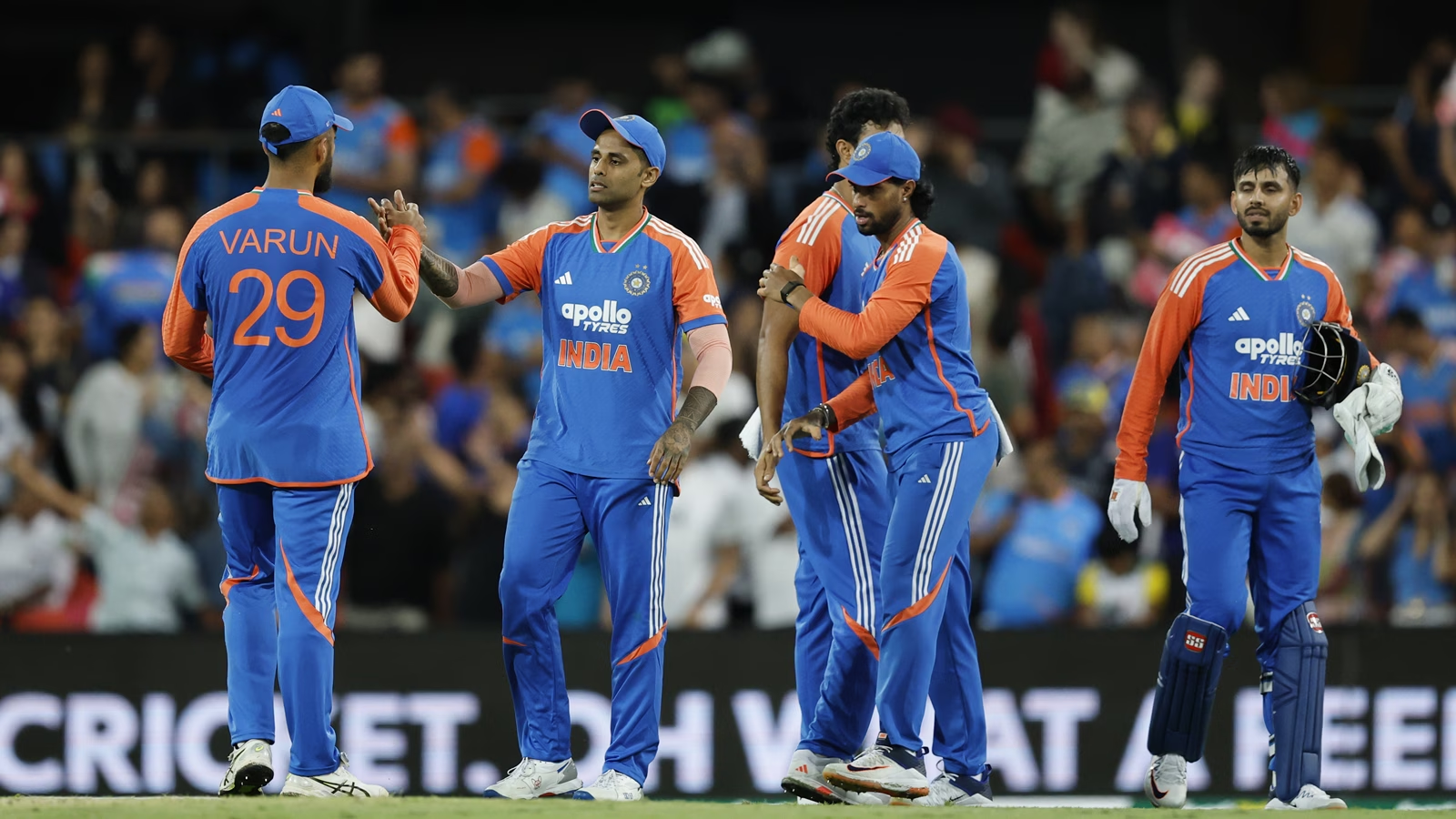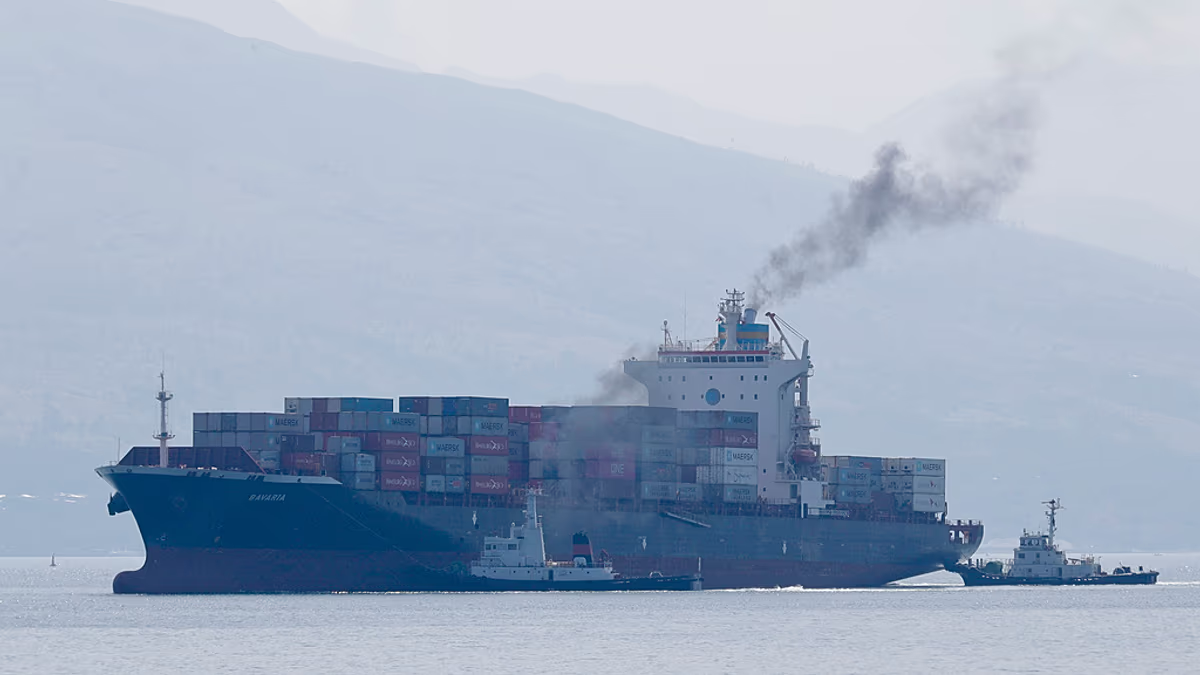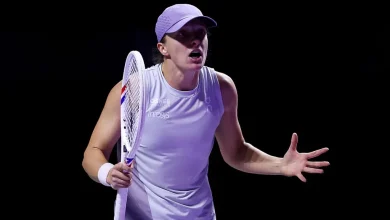Another spin challenge for South Africa as Maharaj is set to return for final test against Pakistan

RAWALPINDI, Pakistan (AP) — World test champion South Africa will be heavily relying on its fit-again spinner Keshav Maharaj to level the two-test series against Pakistan as yet another dry pitch is prepared for the second test, starting on Monday.
Pakistan notched an emphatic 93-run victory inside four days on a turning wicket in Lahore in the opening test of the new World Test Championship cycle for both teams with left-arm spinner Noman Ali bagging a match-haul of 11 wickets.
Click to Gallery
Pakistan’s Sajid Khan, left, and teammates celebrate after the dismissal of South Africa’s Ryan Rickelton during the fourth day of the first test cricket match between Pakistan and South Africa, in Lahore, Pakistan, Wednesday, Oct. 15, 2025. (AP Photo/K.M. Chaudary)
Pakistan’s Shaheen Shah Afridi, left, and teammates congratulate each others after winning the first test cricket match against South Africa, in Lahore, Pakistan, Wednesday, Oct. 15, 2025. (AP Photo/K.M. Chaudary)
Ground staff prepare pitch for second test cricket match between Pakistan and South Africa, at the Rawalpindi Cricket Stadium, in Rawalpindi, Pakistan, Sunday, Oct. 19, 2025. (AP Photo)
Ground staff prepare pitch for second test cricket match between Pakistan and South Africa, at the Rawalpindi Cricket Stadium, in Rawalpindi, Pakistan, Sunday, Oct. 19, 2025. (AP Photo)
South Africa’s test team skipper Aiden Markram speaks during a press conference regarding second test cricket match against Pakistan, in Rawalpindi, Pakistan, Sunday, Oct. 19, 2025. (AP Photo)
Maharaj missed out on the first test because he was recovering from a groin injury back home, but his return will bolster South Africa’s inexperienced spin resources that lacked discipline at times in the first test.
The formula of preparing turning pitches has helped Pakistan beat England 2-1 before drawing 1-1 against the West Indies earlier this year.
“Great to have him (Keshav) back in the camp, he brings lots of experience and really good skill sets as well,” South Africa captain Aiden Markram said on Sunday. “It’s an opportunity for us to (not only) level this series, but also to keep improving in these conditions and fixing some of the stuff that we feel needs fixing from the first game.”
Maharaj is the most successful South African test spinner with 203 wickets in 59 test matches and is likely to team up with another left-arm spinner, Senuran Muthusamy, who took 11 wickets at Lahore and was twice denied a hat-trick.
South African middle-order batters found it tough to negotiate Pakistan spin duo Noman and Sajid Khan in Lahore and conceded a 109-run first-innings lead despite Tony de Zorzi scoring a gritty 104 and Ryan Rickleton reaching 71.
Markram said his batters have to adapt to spin conditions quickly.
“We’re expecting the same (spin wicket),” Markram said. “When you get to spinning conditions, the guessing game is always how long until it really starts to spin exaggeratedly … we’ll have to assess that as quick as we can.”
Markram, who is leading the side in the absence of Temba Bavuma, himself struggled, scoring 3 and 20 before falling to Noman in the first test.
“I feel like I’m mentally in a really good space and very hungry to contribute towards the team and lead from the front,” he said. “We know how this game works, it doesn’t always work out, but as I always do, live and die with my heart on my sleeve and give it a good fight.”
Pakistan’s top-order batters were among the runs after the hosts won the all-important toss at Lahore with captain Shan Masood, Imam-ul-Haq, Mohammad Rizwan and Salman Ali Agha all hitting meaningful half-centuries in a strong first-innings score of 378.
Babar Azam also showed signs of his return to batting form with a knock of 42 off 72 balls in the second innings when Abdullah Shafique (41) and Saud Shakeel (38) also made useful contributions.
A dry surface could encourage Pakistan to include leg-spinner Abrar Ahmed as a third specialist slow bowler to team up with Noman and Khan. Red-ball head coach Azhar Mahmood said a final decision will be taken before the toss on Monday.
“We might go with a 3-1 combination because the wicket looks very dry,” Mahmood said. “We have a settled top seven, but we will see tomorrow whether we tinker with our bowling line-up or not.”
AP cricket: https://apnews.com/hub/cricket
Pakistan’s Sajid Khan, left, and teammates celebrate after the dismissal of South Africa’s Ryan Rickelton during the fourth day of the first test cricket match between Pakistan and South Africa, in Lahore, Pakistan, Wednesday, Oct. 15, 2025. (AP Photo/K.M. Chaudary)
Pakistan’s Shaheen Shah Afridi, left, and teammates congratulate each others after winning the first test cricket match against South Africa, in Lahore, Pakistan, Wednesday, Oct. 15, 2025. (AP Photo/K.M. Chaudary)
Ground staff prepare pitch for second test cricket match between Pakistan and South Africa, at the Rawalpindi Cricket Stadium, in Rawalpindi, Pakistan, Sunday, Oct. 19, 2025. (AP Photo)
Ground staff prepare pitch for second test cricket match between Pakistan and South Africa, at the Rawalpindi Cricket Stadium, in Rawalpindi, Pakistan, Sunday, Oct. 19, 2025. (AP Photo)
South Africa’s test team skipper Aiden Markram speaks during a press conference regarding second test cricket match against Pakistan, in Rawalpindi, Pakistan, Sunday, Oct. 19, 2025. (AP Photo)
LA PAZ, Bolivia (AP) — Bolivians voted on Sunday in an unprecedented presidential runoff between two conservative, capitalist candidates, ushering in a new political era after 20 years of almost continuous rule by the Movement Toward Socialism party.
The race was in a dead heat as voters, looking for a leader to lift them out of their country’s worst economic crisis in decades, chose between former right-wing President Jorge “Tuto” Quiroga and centrist Sen. Rodrigo Paz.
As tens of thousands of polling stations shuttered across the country, workers counted votes by reading paper ballots aloud while others transcribed the results to transmit electronically to the Supreme Electoral Court, which said it hoped to be able to release preliminary results after 8 p.m. local time.
Since 2023, the Andean nation has been crippled by a shortage of U.S. dollars that has locked Bolivians out of their own savings and hampered imports. Year-on-year inflation soared to 23% last month, the highest rate since 1991. Fuel shortages paralyze the country, with motorists often waiting days in line to fill up their tanks.
Quiroga and Paz have vowed to break with the budget-busting populism that dominated Bolivia under the Movement Toward Socialism, or MAS, party founded by Evo Morales, a charismatic coca growers’ union leader who became Bolivia’s first Indigenous president in 2006.
“We are closing one cycle and opening another,” Paz told supporters as he cast his ballot in his hometown of Tarija, alongside his father, former President Jaime Paz Zamora.
Some voters said they felt energized by the promise of change. Lines snaked outside many polling stations throughout the day.
“Since 2005 we haven’t had any real options, so this is exciting for me,” said high school teacher Carlos Flores, 41, who was waiting to vote for Paz.
Others said they had lost faith in politics itself. Around 10% of voters remained undecided heading into the runoff, according to polls, with many Bolivians wary of a lurch toward privatization and austerity but also incensed at their left-wing government’s profligate spending and corruption.
“Every candidate promises and promises, but when they get to power, they forget about the people,” said Javier Quisbert, 40, an unemployed bricklayer who emerged from a polling station Sunday saying that he spoiled his ballot just to avoid a punitive fine. Voting is compulsory for Bolivia’s nearly 8 million eligible voters.
Riven by internal divisions and battered by public anger over the economic crisis, MAS suffered a historic defeat in the Aug. 17 elections that propelled Quiroga and Paz to the runoff. Paz beat Quiroga but without enough votes to avoid a second round.
Both candidates have promised to end Bolivia’s fixed exchange rate, remove subsidies and lure foreign investment. Among the factors that most distinguish them is how far and fast they propose pushing their reforms.
“We have the opportunity to change Bolivia,” Quiroga said, mobbed by supporters and journalists as he voted in an affluent area of Bolivia’s capital, La Paz.
Quiroga wants to get dollars flowing into Bolivia immediately with a big rescue package from the International Monetary Fund and other multilateral lenders.
That would demand savage cuts in state spending, such as slashing fuel subsidies, shrinking the public payroll and cutting the state out of Bolivia’s gas and mining businesses. He has run for president three times before but never made it this far.
“What’s interesting is that even though Quiroga puts very drastic measures on the table, he has considerable support,” said Gustavo Flores-Macías, dean of the School of Public Policy at the University of Maryland. “It shows that a good share of Bolivians are just so tired of the crisis, the currency difficulties, fuel shortages, that they’re willing to support someone who says there will be pain before things get better.”
Paz favors a more cautious approach. He says he’ll phase out fuel subsidies gradually and provide MAS-style social protections like cash handouts to cushion the blow.
Shunning the IMF — an organization viewed with contempt in Bolivia during the nearly two decades of left-wing rule — Paz promises to scrape together dollars by legalizing Bolivia’s black market and fighting corruption.
Most merchants and shop owners interviewed across La Paz, their thumbs marked with ink after voting, said they supported Paz and and his popular running mate Edman Lara for their proposals to support the poor.
“I want change, I want the bonuses and aid they’ve promised us to become a reality,” said Yola Rojas, a 67-year-old food vendor.
Although Paz spent over two decades in politics as a lawmaker and mayor, he was never a nationally prominent figure until his shock victory in August with the message of “ capitalism for all.” He surprised everyone by picking ex-police Capt. Lara as his running mate, a political unknown with humble origins who testified to the campaign’s focus on the middle class.
Fired from the police force in 2023 for denouncing corruption in viral TikTok videos, Lara attracted former members of MAS who had supported Morales’ subsidies and public works but soured on his taxes and regulation.
Crisscrossing rural communities to throw beer-soaked, no-frills events, Paz and Lara sought to paint Quiroga as an emblem of Bolivia’s out-of-touch political establishment. Quiroga briefly served as president from 2001-2002, after his predecessor Hugo Banzer fell ill and stepped down.
But Quiroga’s supporters say they would rather his professionalism than the scattershot style of Paz and Lara.
“Tuto has the political experience to bring about the change that Bolivia needs,” said Raúl Negrete, 58 after voting for Quiroga,
The excitement was palpable as crowds packed inside classrooms at one high school in central La Paz, silently watching poll workers count ballots. Quiroga’s Libre party collected by far the most votes at that school.
The next president faces a task that’s about as simple as running a marathon in Bolivia’s highlands — altitude: 4,150 meters (13,600 feet).
In the heady early days of Morales’ tenure (2006-2019), a boom in natural gas exports underwrote the state’s unbridled spending. Now, gas exploration and production has collapsed. But Bolivia continues to splurge to keep fuel practically free, paying $2 billion last year on the subsidies.
Previous attempts to lift the subsidies didn’t go well: Morales’ effort in 2011 lasted less than a week as mass protests engulfed the country.
Public transportation unions have already threatened to ignite unrest if fuel subsidies are eliminated.
The end of MAS after 20 years of hegemony triggers a major economic and geopolitical realignment that could reverberate across the continent. Both candidates say they’ll welcome foreign investment and encourage private enterprise in Bolivia, which has the world’s greatest lithium resources.
It also means a shift away from Bolivia’s current allies, China and Russia, and toward the United States after decades of antipathy toward the West. Both Quiroga and Paz flew to Washington to meet with IMF and Trump administration officials last month.
“Both candidates running in the runoff election want strong and better relations with the United States, so that’s another transformative opportunity,” U.S. Secretary of State Marco Rubio said recently.
Presidential candidate Jorge “Tuto” Quiroga waves after voting, accompanied by his running mate Pablo Velasco, right, during a presidential runoff election in La Paz, Bolivia, Sunday, Oct. 19, 2025. (AP Photo/{photo})
A voter casts his ballot during presidential runoff election in Achacachi, Bolivia, Sunday, Oct. 19, 2025. (AP Photo/Juan Karita)
Voters line up at a polling station during a presidential runoff election in Warisata, Bolivia, Sunday, Oct. 19, 2025. (AP Photo/Juan Karita)
Presidential candidate Jorge “Tuto” Quiroga shows his ballot during a presidential runoff election in La Paz, Bolivia, Sunday, Oct. 19, 2025. (AP Photo/)
Presidential candidate Rodrigo Paz shows his ballot during the presidential runoff election in Tarija, Bolivia, Sunday, Oct. 19, 2025. (AP Photo/Freddy Barragan)
A police officer guards a polling station during a presidential runoff election in Tarija, Bolivia, Sunday, Oct. 19, 2025. (AP Photo/Freddy Barragan)
A person checks the rolls during a presidential runoff election in El Alto, Bolivia, Sunday, Oct. 19, 2025. (AP Photo/Ivan Valencia)
A police officer points the way to a polling station for a voter during a presidential runoff election in El Alto, Bolivia, Sunday, Oct. 19, 2025. (AP Photo/Ivan Valencia)
A woman walks past an electoral mural during a presidential runoff election in El Alto, Bolivia, Sunday, Oct. 19, 2025. (AP Photo/Natacha Pisarenko)
Voters line up at a polling station during a presidential runoff election in Warisata, Bolivia, Sunday, Oct. 19, 2025. (AP Photo/Juan Karita)
An electoral official shows an unmarked ballot with presidential candidates Jorge Quiroga, right, and Rodrigo Paz to voters during a runoff election in La Paz, Bolivia, Sunday, Oct. 19, 2025. (AP Photo/Natacha Pisarenko)
A voter casts her ballot in a presidential runoff election in Warisata, Bolivia, Sunday, Oct. 19, 2025. (AP Photo/Juan Karita)
Presidential candidate Jorge “Tuto” Quiroga waves during a closing campaign rally ahead of the upcoming runoff election in La Paz, Bolivia, Wednesday, Oct. 15, 2025. (AP Photo/Natacha Pisarenko)
A car drives past a banner promoting presidential candidate Jorge “Tuto” Quiroga on La Cumbre ahead of the presidential runoff election, on the outskirts of La Paz, Bolivia, Saturday, Oct. 18, 2025. (AP Photo/Juan Karita)
Presidential candidate Rodrigo Paz addresses supporters during a closing campaign rally ahead of the upcoming runoff election in Tarija, Bolivia, Wednesday, Oct. 15, 2025. (AP Photo/Juan Karita)
A woman stands next to a mural promoting presidential candidate Rodrigo Paz on La Cumbre ahead of the presidential runoff election, on the outskirts of La Paz, Bolivia, Saturday, Oct. 18, 2025. (AP Photo/Juan Karita)
This combo of file photos shows presidential candidates Jorge “Tuto” Quiroga, left, on Aug. 17, 2025 and Rodrigo Paz on Sept. 1, 2025, in La Paz, Bolivia. (AP Photo/File)





